Gratis Geschenk ab 40 € | Gratis Versand ab 35 € | Gratis exklusives Plektrum ab 60 €
-
Shop
- Insights
-
Über ROMBO
- Händler
- Plektren-Finder
- Geschenkgutschein
+Kategorien
- accessories
- bass
- bass pick
- bass picks
- bass plectrum
- bass plectrums
- beginner
- bright tone
- chose guitar pick
- chose guitar picks
- chose plectrum
- chose plectrums
- CrystalBright
- Diamond
- Diamond pick
- discipline and guitar
- DIY generation
- durability pick
- durable pick
- eco
- ecoblack
- find guitar pick
- find plectrum
- fingers vs picks
- grip
- grip guitar pick
- guitar accessories
- guitar advantages
- guitar benefits
- guitar career
- guitar health
- guitar injury
- guitar learn
- guitar lesions
- guitar lesson
- guitar method
- guitar noise
- Guitar noise plectrum
- guitar pain
- guitar pick
- guitar pick beginner
- guitar pick bevel
- guitar pick buy
- Guitar pick diamond
- guitar pick durability
- guitar pick durable
- guitar pick eco
- guitar pick features
- guitar pick grip
- guitar pick material
- Guitar Pick Noise
- Guitar Pick online
- guitar pick recycled
- guitar pick recycled material
- guitar pick special features
- guitar pick textures
- guitar pick thickness
- guitar pick variable thickness
- guitar picks
- guitar tone
- guitar warm-up
- guitarpick
- guitarpicks
- hold a guitar pick
- hold guitar pick
- hold guitar picks
- hold pick
- hold plectrum
- hold plectrums
- how to
- how to chose your guitar picks
- jazziii
- learn guitar
- lose guitar pick
- material
- materials
- mental health and guitar
- motivation and guitar
- music
- not to lose guitar pick
- Online guitar
- online guitar pick
- online guitar pick buy
- pick
- pick durability
- pick material
- pick noise
- Picks
- picks vs. fingers
- play bass fingers
- play bass picks
- play bass with fingers
- play bass with pick
- play bass with picks
- play bass with plectrum
- play guitar faster
- plectrum
- plectrum attributes
- plectrum beginner
- plectrum bevel
- plectrum characteristics
- plectrum features
- plectrum grip
- plectrum material
- plectrum noise
- plectrum recycled
- plectrum shape
- plectrum variable thickness
- plectrums
- Plek
- pua
- recycled
- recycled guita pick material
- recycled guitar picks
- recycled picks
- recycled plectrum
- Rombo Diamond
- rombopicks
- tendonitis guitar
- the guitar pick
- tone
- variable thickness
- warm tone
- warm-up guitar

Thick Guitar Picks vs Thin Guitar Picks
Thin guitar picks vs. thick guitar picks. This eternal battle has been a part of every guitarist's conversation for decades. It is time to finally evaluate both alternatives in depth.
The thickness of a guitar pick is generally measured in millimeters, and it is an attribute that influences many physical aspects like tone and flexibility. For most players, this is considered the most important attribute when choosing the right guitar pick.

However, after doing some online research, nobody seemed to really know how thick a guitar pick needs to be to be considered as a thick or heavy guitar pick. Where is the line?
Therefore, the first thing we did was to create a big online survey on our Instagram guitar community.
1- What are considered Thick Guitar Picks? Thoughts from the Guitar Community
The survey we created was online for 24 hours on an Instagram story and the participants were asked to answer two simple questions.
Personal preferences - thick picks or thin picks?
This question was the first one, and its aim was to see if guitar players prefer thick or thin guitar picks. Here are the results:

It seems that over two thirds of the guitar players prefer guitar picks considered as thick. Honestly, I thought there would be a 50-50 relation and this surprised me a lot.
What do you consider as a thick guitar pick?
This was the second question, and the guitar players could select different thicknesses they considered to be the “least thickness needed for a guitar pick to be considered as thick or heavy”.

The results showed that on average, a pick must be at least about 1.0 mm to be considered as a thick guitar pick.
These results are very interesting, since the information we found during the research claimed that a pick is considered as “thick” or “heavy” if it surpasses 0.8 mm thickness. We did not find any study or survey with more participants than ours.
Of course, we have to consider that we do not have any way to track more specific characteristics of the participants like skill level, music preferences, guitar type, age, and so on.
Average thickness of guitar picks over time
Additional research on this topic showed that during the past decades, the average thickness of the guitar picks has increased substantially. Thin guitar picks are even considered as vintage by many players due to the tone they produce.
This is no surprise, given that most modern guitar techniques and effects that require thick picks (like shredding) were non-existent during the 1950s and 1960s.

2- Why does guitar pick thickness matter?
The thickness of a guitar pick is one of the most influential attributes.
The guitar pick thickness influences:
- The flexibility of the pick
- The tone produced by the pick
- Volume and body of single notes
- The pick noise created by the pick
- The durability of the pick
- The control over the pick
- The feedback you will receive from the pick
A minimal change in the thickness of a guitar pick of only 0.2 millimeters (equal to two common paper sheets) is enough to change the properties of a guitar pick drastically.

3- Thick guitar picks vs. thin guitar picks:
Let's pretend there are no medium guitar picks and create a clear line that divides both thickness ranges, to make the differences between thick picks and thin picks more appreciable.
|
|
Thick / heavy guitar picks |
Thin guitar picks |
|
Flexibility |
Rigid/very rigid |
Flexible/very flexible |
|
Tone |
Warm/dark tones and mellow tones. |
Lighter tones, less bass. |
|
Volume |
Provide high volume. Broader dynamic range |
Maximum volume is limited. Lower dynamic range |
|
Guitar pick noise |
Reduced pick noise |
Noticeable pick noise |
|
Durability |
More durable |
Less durable |
|
Control |
High control of single notes |
Less control for single notes |
|
Popular techniques |
Lead guitar, shredding, sweep picking,... |
Rhythm guitar, strumming, tremolo picking |
|
Common type of players |
Intermediate and advanced guitarists |
Beginners, acoustic guitar players. |
Thick picks: Summary
Thick guitar picks will provide mellower/darker tones. The common rounded edges that can be manufactured with thicknesses over 1 mm – combined with their rigidity – increase the bass tones and the volume these guitar picks can provide, while reducing the pick noise the pick produces.
These picks provide more control over single notes and are usually the best option for lead guitarists.

Most advanced guitarists prefer thick picks, because in their guitar journey they develop new guitar techniques that can be performed better using this kind of picks. Thick plectrums provide more control when it comes to single notes and complex guitar pick techniques like pinch harmonics.
One of the biggest advantages of using heavy picks is the durability they provide. Nevertheless, the lifetime of a guitar pick is influenced by many other aspects, as we learnt in the article “Durability of a guitar pick”.
Thin picks: Summary
Thin picks are the best option for guitarists looking for brighter tones, especially using acoustic guitars and some strumming techniques on electric guitar.
The flexibility of these picks limits the maximum volume that can be achieved. This can be an advantage because it works like an analog limiter. This is especially helpful in a studio session, where the maximum volume achieved must be controlled.

Most beginner guitar players start using thin picks because their guitar skill set at the beginning includes guitar techniques like strumming.
Note control can be difficult with thin guitar picks. However, some players use this attribute for specific guitar techniques, like in surf music, where a super fast tremolo picking is required.
4- Example of a thick guitar pick: Rombo Jade
Rombo Jade is the perfect example of a thick guitar pick. Thanks to its thickness, a very large bevel edge could be implemented to be as sharp as possible, providing the precision needed when using these kinds of picks.

The size is small, a typical attribute of thick guitar picks, and its shape ends with a very pointy guitar pick tip for maximum attack.
5- Example of a thin guitar pick: Rombo Classic
Rombo Classic is the thinnest Rombo guitar pick. In the middle, it is only 0.38 mm.
This guitar pick is extremely flexible and has a medium/large size with a standard 5 mm diameter guitar pick tip.

In spite of its thickness, the dynamic range of the pick is great. This is caused by the material used in our picks.
6- The right guitar pick thickness for you
I am sure you already have an idea of your favorite guitar pick thickness. In case you don’t, it is probably because you are at the beginning of your guitar journey.
Is there a wrong guitar pick thickness to play guitar? Any pick you use to get sound out of your guitar can work, if the sound produced is the sound you are looking for. It is entirely a matter of personal preference.
If you are a beginner guitar player, I recommend you start with something like 0.75 mm, as I described here: "Guitar Picks for Beginners"
However, if you are an intermediate player trying to find a way to discover new guitar tones, I do not have better advice than to tell you to try many different thicknesses and start integrating other important aspects of the guitar pick in your decision, like materials, size, shape, etc...

The good news is, you will probably end up having 3 to 5 favorite guitar picks which you can use for different techniques. So, enjoy the journey and be open to experimenting with different tones and textures with your guitar!
7- Current guitar pick thicknesses at Rombo:
For this chapter I included the new guitar picks, which will be officially released during 2021.
As you can see on the thickness scale, there are still some slots missing (for example something like 0.6 mm), we will be filling them in the future, as we design new guitar picks.

However, we might repeat thicknesses if other aspects change a lot, for example the shape, the sharpness of the tip, the size of the pick, or other grip textures.
8- Variable guitar pick thickness
Another important factor to consider is that some picks do not have constant thickness along its design. But why?
As we did our research back in 2018, we found out that designing guitar picks with variable thickness comes with many advantages.
Let's take Rombo Origami as an example: The guitar pick tip is 0.75, but its hold area is thicker. This simple change makes the pick produce darker and mellower tones without losing much of its flexibility.

In the case of Rombo Diamond, the middle area (where all vertices collide) the thickness goes up to 2.65 mm. We increased this area after experiencing that the relation between the thicknesses along the guitar pick also increases the control over the pick for single notes.

In addition, with more thickness on a given material, you have more possibilities to introduce design elements, like the 3D geometries we use in our picks. These geometries have two positive effects: on one side, they enhance the grip of the pick because of the tilted surfaces, and on the other side, the guitar picks look very cool!
In short, variable thickness will make your picks more versatile and give you extra control.
9- Conclusion
Thick picks vs. thin picks will remain a hot, trendy topic in the guitar community.
However, if you are already an intermediate player with some knowledge about equally important aspects of a guitar pick like shape or material, spread the word to avoid confusion among the newcomers.
We have already discussed the huge variety of different guitar picks you can find online in our article “Guitar picks online” since this can be overwhelming for some beginners.
The best advice I can give you: love both thin and thick picks and try to understand why they are different. Both need to exist in a world where creativity and different tones and styles are needed!
Now it’s your turn, what is your favorite guitar pick thickness?

Inside Rombo Guitar Picks: Guitar Picks developed and engineered in Germany
This article was created because you asked for it. It is meant to be as transparent as possible, so that you can see who the faces behind Rombo are and how we organize this project internally.
We hope you enjoy it!
Rombo Guitar Picks: Short Introduction
Since 2019, Rombo has been researching surface finish and design in order to find the perfect balance between grip, ergonomics, and function in guitar picks and other guitar accessories. Rombo was born thanks to an amazing guitar player community whose aim is to continue this adventure and quest for the perfect guitar accessories.
Who are the faces behind Rombo Guitar Picks?
We are Judith and Carlos, a happily married couple trying to innovate in the world of guitar picks. We live near Stuttgart, Germany.

We both love music, guitars, product development, challenges, and attention to detail, so Rombo was the perfect excuse to mix all these things together and have some amazing adventures.
Our location in Remseck a.N., Germany
Packing and shipping of our guitar picks
From Remseck, near Stuttgart in Germany, we do almost everything.
Here, we receive the packaging and the dots we use to fix the guitar picks to the packaging. We try to be very organized and keep the place very tidy. Tidy places also look better for photographs!

In the shipping station, there is one tray for every guitar pick model. We also include a flyer and a “thank you”-card with every delivery. This way we make the experience more personal, while sharing our journey of packing your guitar picks directly with you!

We have a label printer, which is super useful, and thankfully our web system allows us to automate the printing for every customer and create a label with just one click.
Our post carrier receives the boxes from us with all the information they need to bring our products to you, including weight, countries, and import information for the customs.

We ship every order directly from our location.
The envelopes we use are not very cheap, but they protect the product well, they are made of 100% recycled paper and they are plastic free.

Always learning something new
We have to be very multifaceted to cover all the tasks we do, from idea generation, product development, graphic design, photography, web maintenance, logistics, social media, packaging development, and accounting, to all the stuff a start-up involves.

We believe that doing everything by ourselves gives us a very close perspective from the customer side.
This means, when you ask something on Instagram or Facebook, you receive an e-mail from us, or we answer your comment. It is us behind the screen typing every word and every smiley!

We love walking a lot. We go for a walk for 5 kilometres almost everyday. Almost every idea we applied to Rombo was created while having a walk. We called it our daily inspiration walk.

Rombo is a long journey
Two years ago, at the very beginning of this journey, we could not have imagined how many things we needed to learn!
We have encountered many challenges on the way; for example, I remember it was very difficult to find out how to sell internationally and establish a system that is fast enough for us.

I cannot tell how many books on startups, online marketing, Kickstarter or time management we have read! One of the most useful ones was A Crowdfunder's Strategy Guide: Build a Better Business by Building Community, by Jamey Stegmeier.
A funny anecdote is that Judith and I don’t have our own Instagram profiles. For the first post from Rombo, we had to check out a tutorial on Youtube to try to understand the process. I am glad to say that two years later, we have reached almost 20K followers!
PS: We still don’t have our own accounts, the one for Rombo is enough work! :)
Guitar picks: All about the design process
The most complex part is the design process of a guitar pick.
I like to sketch a lot, so I have lots of old ideas and sketches which I use as an inspiration source. Sometimes, we use questions to challenge the design process, like “Is it possible to create a guitar pick that is flexible and rigid at the same time?” While trying to answer this question, we came up with the idea of “variable thickness”, which has proven to substantially increase ergonomics.

Since we have an engineering & design background, we also do the modeling in 3D and product engineering. Every detail is important here to create high-quality products.

When we think the design is ready, we create some prototypes and send them to the testers. If you follow us on social media you will know some of the testers from our stories.
In total, we have about 30 guitar players that help us during this phase of the project and communicate with us which points they liked or didn’t like. Thanks to their feedback, we are able to improve areas of the guitar picks which we would otherwise not have thought of.
Manufacturing technologies
For the manufacturing of our guitar picks on a large scale, we use a technology called injection molding.

In this process, the melted raw material is injected into a mold with the negative shape of the guitar picks.
It is a very complex process with lots of engineering in it, the material has to be treated in a special way to keep the proper humidity, temperature and pressure, and to avoid external contaminations.

On the left, the injection mould from Rombo Diamond: Our polimer flows through the mould runner (yellow arrows) after it reaches over 270°C degrees and it is pushed forward.
The red area is the area we use for the grip texture. The blue area is high mirror polished.
On the right: The first ever produced Rombo Origami from 30.11.2018. The first 50 guitar picks we produced were sent to guitar pick testers who gave us feedback about the material, the grip, the tone and the shape.
The raw material we use is produced in Italy. We have worked very closely with our material partner to accomplish every requirement we had, including the 100% recycled material of the EcoBlack sets. If you want to know more about the materials we are using, you can find more information HERE.

Packaging for guitar picks
We believe packaging is a very important aspect of a product. We not only use it to create an atmosphere and emphasize the quality of the product, but also to inform you about the attributes of our guitar picks.

This is the reason we created packaging with lots of printable areas to describe the guitar picks. We include our parameter bars, a short description of the guitar pick, the 6 special attributes of a Rombo guitar pick, and a QR-code with extra information.
We had a total of about 6 different concepts before we decided which one was the most suitable.
Right now, we are creating the packaging layouts for the new models that will launch in 2021. We have received some samples and they look great!


If you want to see the new models, you can click HERE.
Guitar picks and social media:
Rombo product photography:
Carlos takes the pictures for social media. We are not very skilled with the camera, but we have learned a couple of tricks and after thousands of trials, we are able to take decent pictures in our living room.

In our Instagram you can find the best pictures.
Educating the customer
You have probably noticed that our posts on Instagram are mainly informative. Guitar picks are often underrated and most guitar players don’t think much about it.
However, guitar picks are the loudest amplifier you can have in your hands and are the bridge between you and your guitar.

We try to pass the know-how we have obtained directly to you, so you can make conscious decisions about the products you purchase. Aspects like the variations on the tone depending on guitar pick thickness, or why are there so many guitar pick shapes and materials… And this is the reason we created our blog articles.
Our aim is to create a communication process that goes back and forth between us. Some of you have become friends of ours and have won a new perspective of thinking about guitar picks.
Engagement of the community
“To listen closely and reply well is the highest perfection we are able to attain in the art of conversation.” – François de La Rochefoucauld, essayist.
We believe we have one of the most engaged communities ever! We try to answer every comment and every private message, and we are sure we have an answer rate very close to 100%.
You all have participated in surveys, and you have left amazing comments and reviews. You post stories regularly and we have had very deep conversations with some of you! Thank you!
We also received great support from many amazing blogs like Heavy Repping, Gigs and Guitars, The Gadget Flow, Ultimate-Guitar, Guitar World, and others.
Rombo around the world
Rombo is expanding. We are working with dealers around the world and currently we have sellers in the following countries:

This means, with the help of our dealers we are able to sell in Europe, North America, Asia, Australia, almost every country of South America, and South Africa.
Transparent communication with our dealers is a priority with us, and so far 100% of the new sellers stay with us! Together we are developing the brand and taking it to the next step.
The future of rombo:
During our inspiration walks, we talk about Rombo in the next few years. It is very difficult to imagine what the future will bring.
We would like to bring new designs (lots of them!), to increase the amount of recycled material for the manufacturing of the picks, or even be able to create colored recycled guitar picks. We want to talk more to our customers and share our experiences, and from time to time, share some great music and playlists.
We are only two people and every step takes its time. Some of you have written beautiful thank you letters to us or left very good reviews and we want to let you know that we are working hard everyday not to disappoint you :)
You are the best and you have a vote on the future of Rombo!

Picks vs. Fingers for Playing Bass Guitar
You have probably heard this question many times: Should I use a pick or my fingers to play bass? You can find a huge amount of different answers on the Internet and still be confused.
My philosophy is, to never limit yourself. Both methods are valid and appropriate for the right musical context.
Picks vs. Fingers: The Eternal Debate
Whether using picks or using your fingers, each technique has its place and, ideally, you need to feel comfortable with either one you choose.
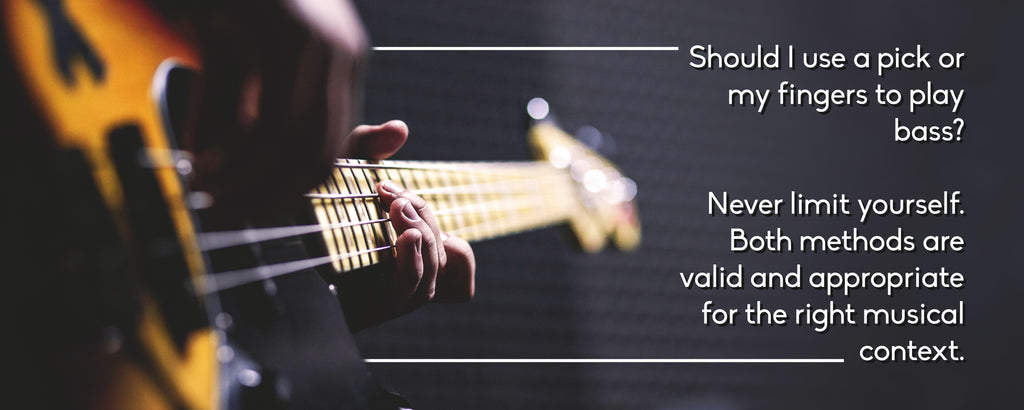
Is there a wrong way to play an instrument? Any method you use to get sound out of your instrument - fingers, pick, nails, palms of your hands, etc - can work, if the sound produced is the sound you are looking for. It is entirely a matter of personal preferences.
Therefore, this is an unimportant debate, if your plan is to be a versatile musician, and be able to understand the rich parts of every bass line, regardless of the method used to play them.
For me, it is difficult to understand how this debate has been one of the most controversial topics since the advent of modern music creation decades ago.
Why not keep an open mind and become comfortable with both methods? There is room for everything.
Using Fingers to Play Bass
Usually, bass players report having more control when using their fingers, giving them a richer tonal variety, and beefier tone. In Addition, the popular slap technique used by many bassists can be easily implemented, if you don’t hold any pick between your fingers.
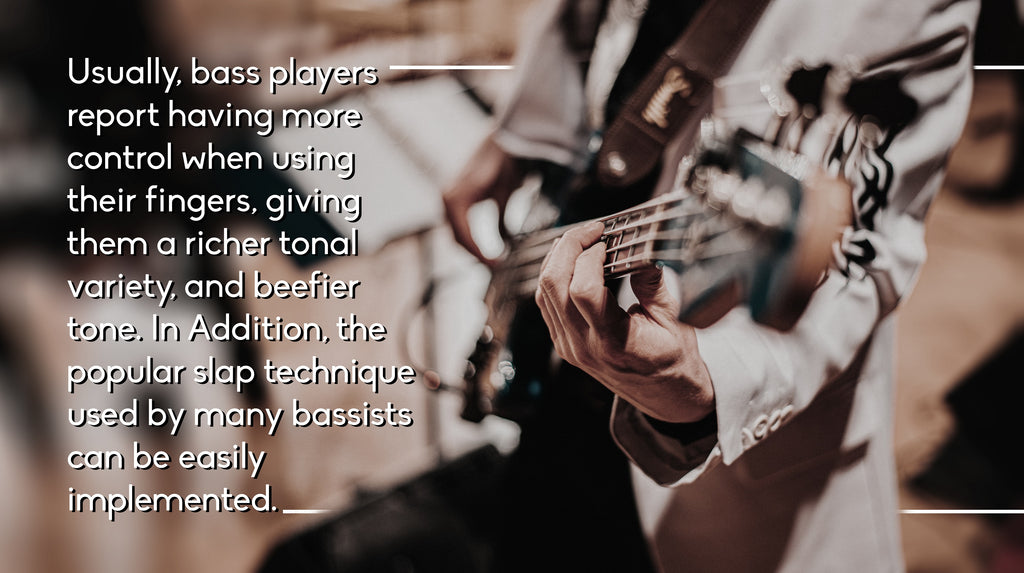
A funny positive argument is, that you will never lose your bass pick if you don’t own one.
One of the drawbacks of this method is that it takes a little more work to learn. Nevertheless, if your goal is long-term learning, this should not be a technical obstacle.
Using Picks to Play Bass
The biggest advantage of using a pick for the bass guitar is obvious: Instant speed. You can develop speed more quickly and effortlessly.
If the bass lines you want to learn, belong to certain music styles that are speed intensive, a pick might make sense. You can develop the same speed as with your fingers, but it will take much more time.
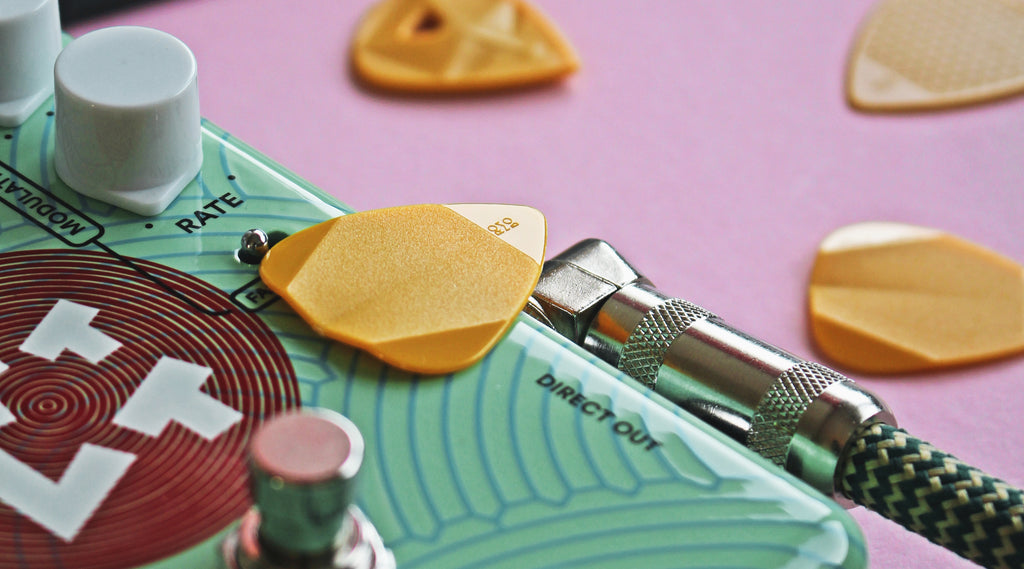
In addition, the tone can be easily changed by using a different guitar pick. This allows you to have different tones, and experiment a lot to find the right sounding bass guitar pick.
Every pick - for guitar, bass, or other instruments - has four different main parameters: Shape, material, thickness, and size. Combined together, they result in a very specific range of tone textures, attack soundwaves, and feedback. Therefore, choosing your guitar pick is one of the most difficult tasks. We have created a guide HERE, that will help you find your tone.
Pick Thickness for Bass Players
Bass players generally use thicker picks. The thickness improves the bass playing control, and the overall tone of the string.
The average pick thickness for bass players is 1.17 mm, while for guitar players is 0.89 mm. Remember, bass strings are much thicker than guitar strings. Therefore, a thinner plectrum will give you much less control in comparison to a thicker plectrum.
The size of the pick will also have a role in the creation of the tone.


Having said that, there are still many bassists who do prefer to use thinner bass picks, like for example Rombo Classic, or Rombo Origami.
If you have no idea where to start, take the average value and look for picks with a gauge of about 1.2 mm. This is a good place to get started. From there, you can go up and down and try other picks depending on your preferences. It might be a good idea to look for the bass picks your favorite players use, and try to understand why they do so.
Most Popular Pick Shapes for Bass:
The truth is, most classical shapes tend to have an excellent reception between the bass players.
The most popular shapes are the classical teadrop pick shape, the rounded teardrop pick shape, and the triangle pick shape.
In addition to shape, there are many other attributes that define a pick. HERE you can read about the 6 most underrated attributes of guitar and bass picks.
Teardrop
Teardrop is the most popular and known type of guitar and bass pick. Semi-sharp point for quick attacks, that maintain a wide range of possibilities, depending on the thickness and material used.
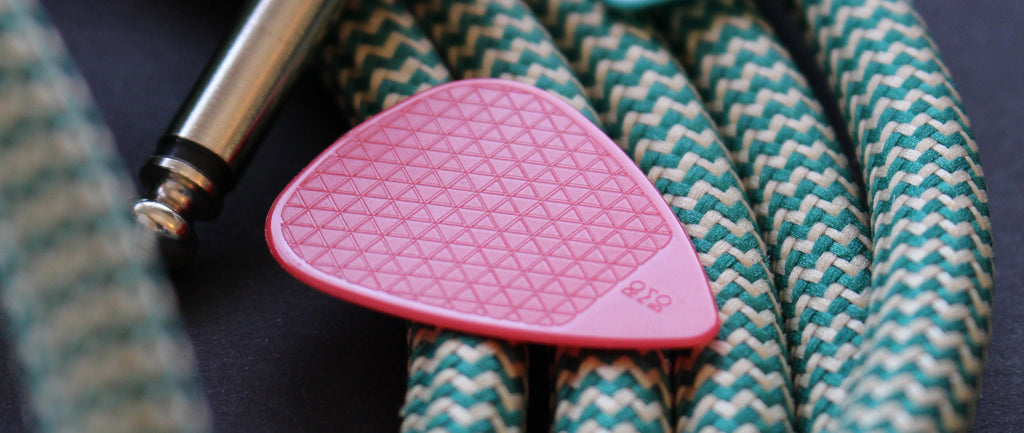
Rounded
Rounded picks provide a more warm sound and smooth attack. These are for the bass players looking for a way to play the bass strings with less force and attack. Sometimes they are totally free when a teardrop pick is completely worn down.
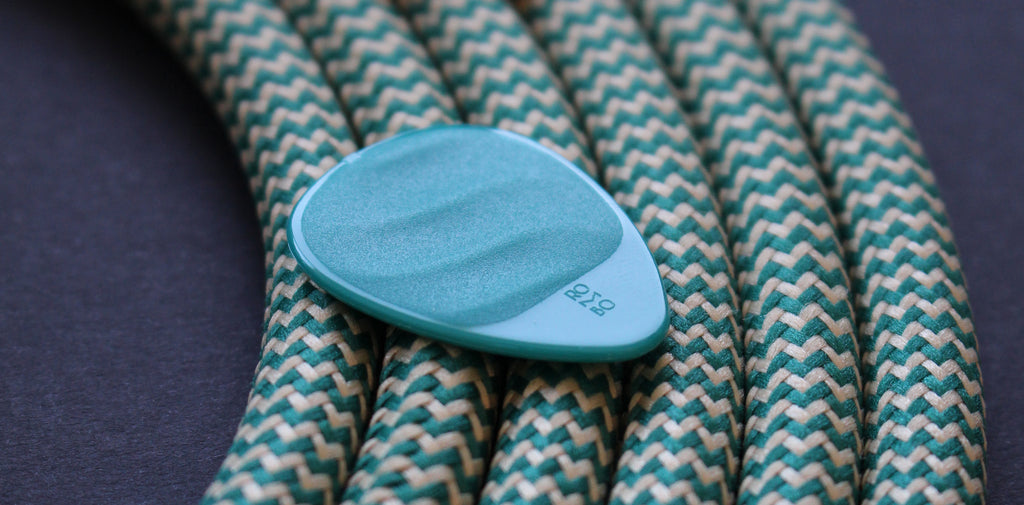
Triangle
A triangle pick is the most practical option because of the tri-sided feature. You can pluck your string with any of the three pointy tips this pick provides. A triange pick is recommended for those players who constantly break the tips of their picks.

Pick Materials for Bass Players:
When it comes to bass, we apply the same rules as with guitar picks.
After studying the physics of guitar picks, and all the material possibilities we have, we came to the following conclusions. The pick material should:
- feel nice to the touch and be comfortable, yet provide grip
- be able to create clear tones, without compromising the bass tones
- be very versatile: feel flexible when thin, and feel stiff when thick
- be durable
- look nice

You can read all about materials used at Rombo HERE.
You will also find a link with the information about Eco-Black - These picks made out of 100% recycled fibre waste, that we manufacture ourselves.
The durability of Bass Picks:
Because the strings are thicker, and bass players tend to play with more energy, the lifetime of your pick will be substantially reduced.
A way to reduce the wear and tear of picks for bass is:
- Using thicker picks
- Using harder materials
- Using picks with polished tip
- Using triangle picks (3 tips take longer to wear down).
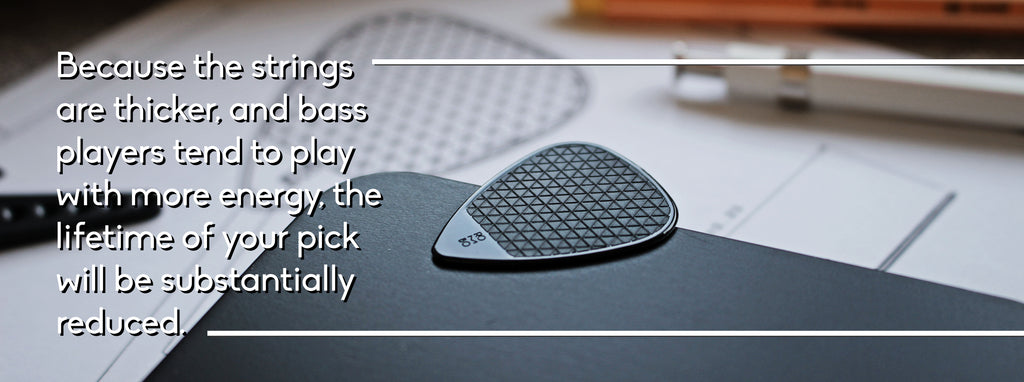
Conclusion:
Playing bass with a pick is as valid as using your fingers, if this is the tone you are looking for.
Finding a pick you are comfortable with, is a difficult task, but testing lots of them and recording some of your bass lines can help you find a balance between the tone you want, and the feel and feedback you wish from the pick.
In picks, qualities like thickness, material, shape, and size play a pivotal role in tone, feedback, grip, pick noise, sustain, etc... Music is about staying dynamic and monotony kills dynamic. Therefore, the most logical step for you is to explore enough to understand as many aspects of the bass as possible.
This applies to guitar gear in general (including picks, strings, cables, etc...) and your practice habits, style preferences, and your own psychological bias/barriers.
Sometimes the best place to start is testing a Variety Pack

Folge uns
Judith Heindorf & Carlos Diez Macia GbR
Auf der Steige 29
71686 Remseck am Neckar
DEUTSCHLAND
- Shop
- Händler
- Impressum
- AGB
- Widerrufsrecht
- Versandbedingungen
- Datenschutzerklärung
- Kontakt
- Presse
- Fragen & Antworten
Melde dich zu unserem Newsletter an und erhalte alle Neuigkeiten zu Sales, Neuerscheinungen und vielem mehr…
Mit der Anmeldung stimmst du unseren Datenschutzbedingungen zu.
© 2025 ROMBO.
ist eine registrierte EU-Marke.
Wir nutzen Shopify.

